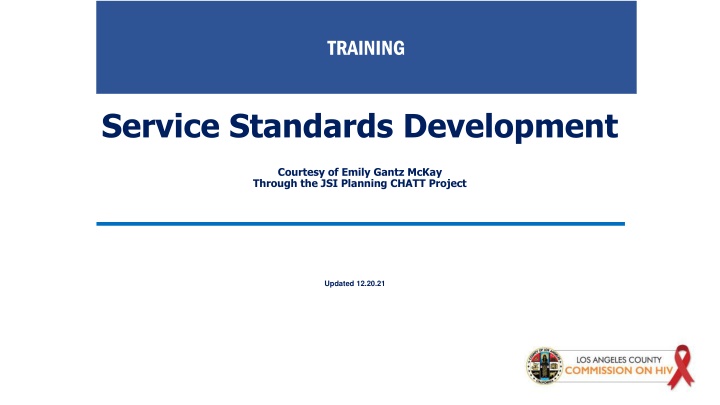
Guidance on Developing Service Standards for HIV/AIDS Programs
Learn about the importance of service standards in HIV/AIDS programs, the responsibilities of recipients in developing and implementing these standards, as well as the key considerations and best practices involved. Discover how service standards contribute to ensuring consistent and quality care for individuals affected by HIV/AIDS.
Download Presentation

Please find below an Image/Link to download the presentation.
The content on the website is provided AS IS for your information and personal use only. It may not be sold, licensed, or shared on other websites without obtaining consent from the author. If you encounter any issues during the download, it is possible that the publisher has removed the file from their server.
You are allowed to download the files provided on this website for personal or commercial use, subject to the condition that they are used lawfully. All files are the property of their respective owners.
The content on the website is provided AS IS for your information and personal use only. It may not be sold, licensed, or shared on other websites without obtaining consent from the author.
E N D
Presentation Transcript
TRAINING Service Standards Development Courtesy of Emily Gantz McKay Through the JSI Planning CHATT Project Updated 12.20.21 1
HRSA HAB Guidance on Service Standards Purpose: Ensure that all subrecipients provide the same basic service components Establish a minimal level of service of care for consumers throughout the jurisdiction For the recipient: Set a benchmark by which services are monitored, and sub-grantee contracts are developed * For CQM: Set the foundation for the clinical quality management program, and provide the framework and service provision from which processes and outcomes are measured * * Source: Service Standards: Guidance for Ryan White HIV/AIDS Program Grantees/Planning Bodies, 2014 2
Guidance, cont. 2014 Guidance* says: Recipient is responsible for the development, distribution, & use of service standards For Part A programs, developing service standards is a shared responsibility, typically led by the Planning Council Medical care standards must be consistent with HHS/Public Health Service (PHS) care and treatment guidelines and other clinical and professional standards Non-clinical/support services may use evidence-based best practices, National Monitoring Standards, and/or guidelines developed by state or local government 3
Guidance, cont. Not directly addressed in the legislation or in the Part A Manual Because national service standards are not feasible due to differences in state and local requirements, they must be developed at the state and/or local level Required for every funded service category Service standards should: Reflect the programmatic and fiscal management requirements outlined in the Part A and B National Monitoring Standards Include input from providers, consumers and experts Be publicly accessible 4
Recent Guidance from HRSA HAB Jurisdictions should not include HRSA HAB performance measures or health outcomes in their service standards Recipients include service standards in their RFPs Potential subrecipients indicate in the application their ability to meet the standards Selected subrecipients have performance measures in their contracts Recipient monitoring addresses whether these measures, which are based on the service standards, are being met Outcomes are essential to measure the impact of services delivered If completely compliant: subrecipients are not meeting client outcome measures such as adherence or viral suppression, this suggests that service standards may need review and refinement 5
Value of Flexible Service Standards Permit staff to adjust service delivery to meet the needs of individual clients Allow adaptations needed for culturally and linguistically appropriate services since one size does not fit all clients Encourage continuing service refinements by providers Support innovative approaches and pilot projects to improve services and outcomes without delays for revising standards Avoid excluding qualified service providers Reduce the need for frequent revisions to Service Standards 6
Developing Service Standards No specified process No required format but structure can improve clarity Broad guidance on required content Differing views/approaches on: Level of detail and how prescriptive standards should be HRSA concern with avoiding confusion between: Quality Assurance done through recipient monitoring, based partly on service standards, and Clinical Quality Management (CQM) activities aimed at improving patient care, health outcomes, and patient satisfaction 7
HRSA Guidance on Developing or Updating Service Standards Agree annually on service categories to review/update based on: Including all service categories that are currently funded or have been allocated funds for the next program year Prioritizing reviews based on a service category s allocation level or local priority or the recipient s RFP schedule Agree on an outline to be used for all service category-specific service standards Review each set of standards at least every 3 years Obtain technical input from providers, consumers, and other experts, including RWHPA-funded and other providers Be prepared to review/revise service standards to respond to environmental or continuum of care changes [like those due to COVID-19] 8
Commission Approach to Developing, Reviewing, and Refining Service Standards (2010 Procedures) 1. Develop: For all services in the continuum of care Questions: Is priority given to funded service categories? What other factors are considered? 2. Review: Every 4 years Question: Should reviews include categories that are not funded and are unlikely to be funded? Question: Are there specific directives from PP&A to SBP or recommendations from DSHP on which standards to update? 3. Update: Before regularly scheduled review, due to: Changes in the continuum of care Changes to the service category nationally, statewide, or locally Problems with service implementation requiring action Incorporation of best practices 9
Annual Service Standards (SS) Cycle Commission review and public comment period SBP review and revision of service standards (SS) Committee scheduling of reviews, based on PP&A service rankings/directives or DHSP RFP schedule ERP input/review, with DHSP participation Use of SS in RFPs, contracts, monitoring/quality assurance SS to DHSP Final Commission approval of SS Feedback to Commission on subrecipient implementation Dissemination of SS, including to non-RWHAP Providers via COH website Encouragement of SS use by non- Part A providers Revisions to SS if needed 10
Roles for the Recipient (DHSP) Ultimate responsibility for ensuring service standards are developed, updated as needed, and used Use of service standards in: Subrecipient RFPs Subrecipient contracts Monitoring/quality assurance Providing summary information to the Planning Council (Commission) on the extent to which service standards are being met (based on monitoring) Identifying possible need for revisions to service standards, because: Subrecipients are following them, but medical outcomes are not good Subrecipients are finding it very difficult to meet some standards Service standards are discouraging flexibility needed for service innovations or appropriate care for diverse populations 11
Provider Familiarity with Service Standards Many clinicians/service staff have multiple roles: Work full-time for a Part A provider, but services to some clients are paid for by Medi-Cal or other third parties Work part-time for a Part A provider, so used to meeting Part A service standards Worked for a Part A provider in the past, so familiar with service standards Unknowns regarding non-Part A clients or roles: Extent to which they apply these standards Extent to which they teach colleagues to use these standards 12
Encouraging Non-Part A Providers to Adopt/Follow Service Standards Incentives: Good preparation if provider may apply for Part A funding in the future Way to ensure service quality Help in providing services appropriate for people with HIV especially if people with HIV are not a provider s only clients Awareness through invitation to serve on an expert panel that helps develop or update service standards Disincentives: Takes effort to learn about these standards if not providing Part A services Requires staff training May cost more 13
Trends/Approaches to Consider 1. Make standards as short and concise as possible Use charts where practical, to increase clarity Put common information into universal standards only, not both places Use plain language Develop standards that tell clients what the service is and what they can expect if they receive it Limit reference to HRSA HAB National Monitoring Standards, Guidances, and Policy Clarification Notices (PCNs) like PCN #16-02 2. Limit sound/best practice content have standards specify requirements Consider providing best/sound practices separately If used, clearly label such content as optional 14
Trends, cont. 3. Closely link Universal and category-specific service standards by putting into the category-specific standards: A statement that they must be used together with the Universal Standards A list of topics covered in Universal Standards An indication that the category-specific standards address these topics only where there are special or additional requirements For example: If the service category has a different income limit from other services or additional eligibility requirements, include only that information do not repeat other information from the universal standards 15
Trends, cont. 4. Put topics like the following into Universal Standards: Access to Services Client Rights & Responsibilities Grievance Process Training, Licensing, & Supervision [General Expectations] Cultural & Linguistic Competency 5. Put the following into service-specific standards: Service Category Definition Key Service Components and Activities Service-specific Personnel Qualifications (including licensure, education, training, and recertification) Assessment and Treatment/Service Plan [Where applicable] Case Closure Protocol [Specific to service category] Agency Policies & Procedures Privacy and Confidentiality (including securing records) Program Safety Intake and Eligibility Transition and Discharge 16
https://hivconnect.org/ 510 S. Vermont Ave, 14th Floor, Los Angeles, CA 90020 hivcomm@lachiv.org 213.738.2816 HIVCommissionLA @HIVCommissionLA














